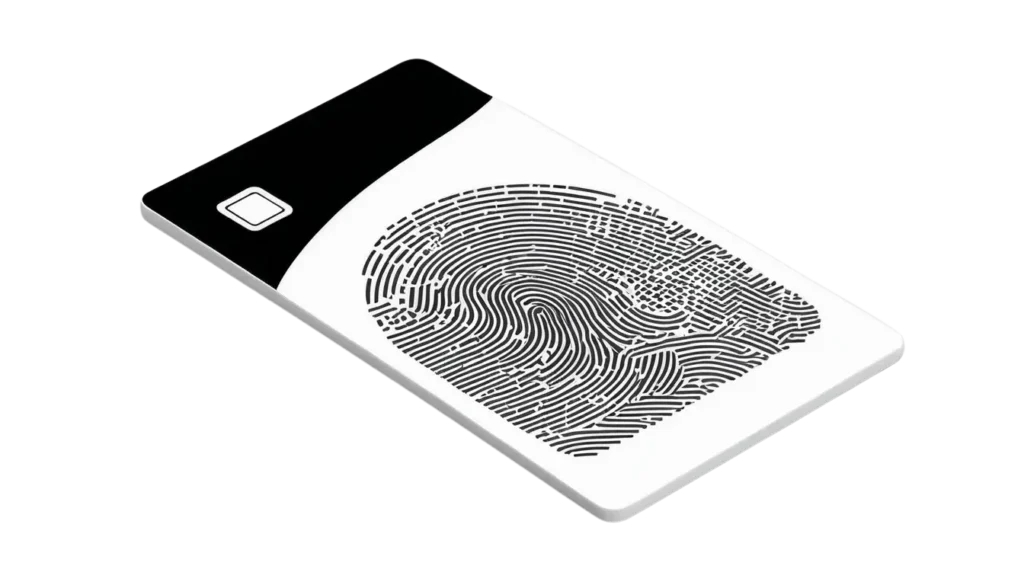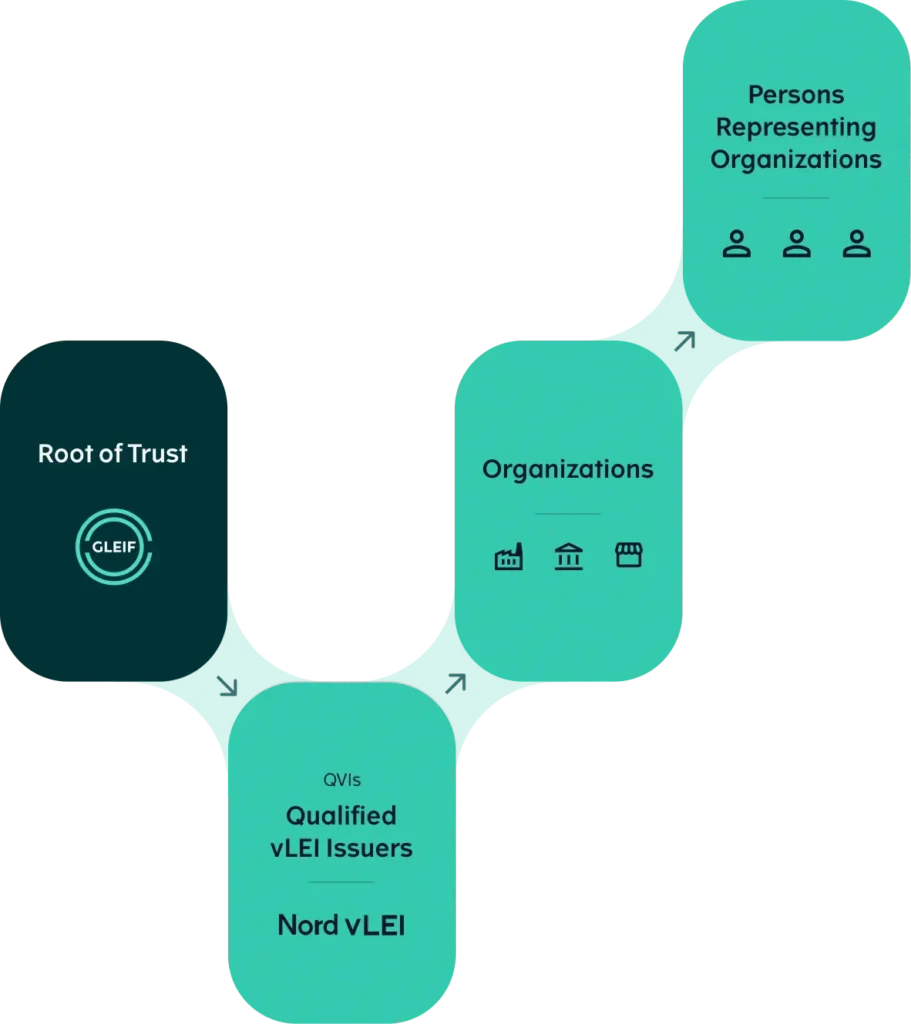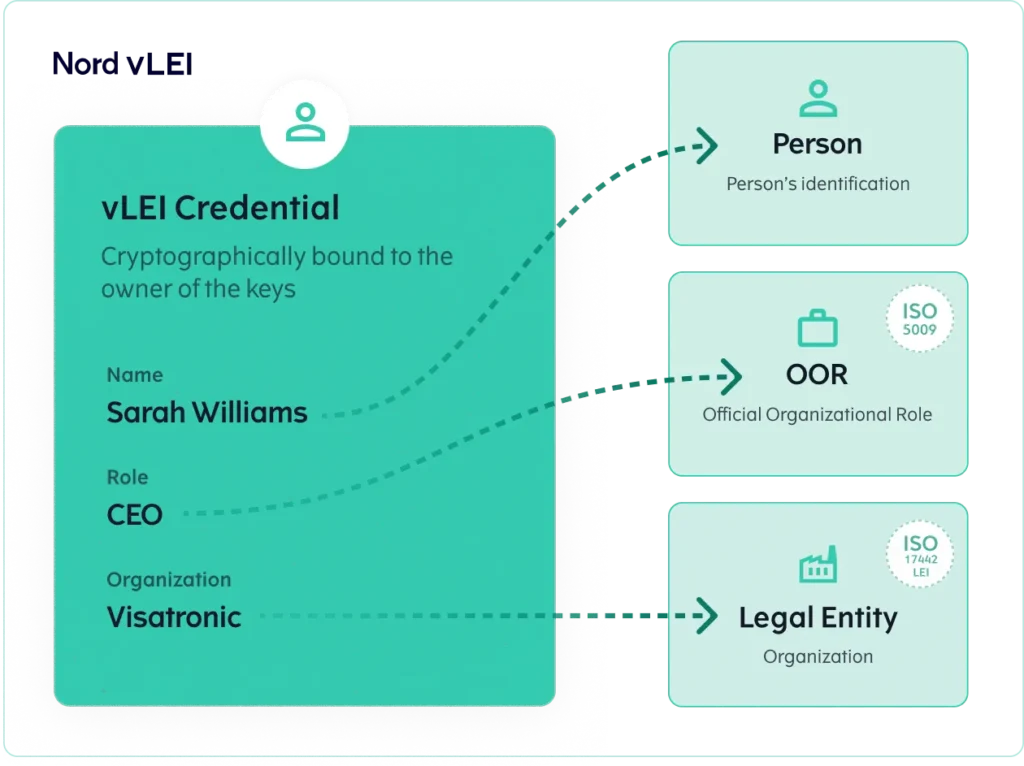
Digital Identity Verification with vLEI
The vLEI is a acronym for “Verifiable Legal Entity Identifier”. It’s a digital and cryptographic evolution of the traditional entity identifier known as LEI. It enables decentralized and automated validation of organizational identities. vLEI also allows the distribution of credentials that link individuals to formal organizational roles, allowing them to authenticate their identity in various activities from financial transactions to official communications.1
The Evolution from LEI to vLEI
The Legal Entity Identifier (LEI) was established in the wake of the 2008 financial crisis, providing a distinct and unique identifier for entities involved in financial transactions. While the LEI system has significantly enhanced transparency in the financial sector, the rapid pace of digital transformation called for its evolution. To meet the needs of the modern digital ecosystem, the Verifiable LEI (vLEI) was introduced. The vLEI retains the unique identification attributes of the LEI and augments them with verifiability, ensuring that the digital identity is both authentic and unaltered.
The Global Importance of Trust and Verification
Trust is the cornerstone of any transaction, be it in the physical or digital realm. In the online world, where face-to-face interactions are replaced by screen-to-screen exchanges, establishing trust can be challenging. Digital identity verification tools, like the vLEI, play a crucial role in bridging this trust gap. The vLEI offers a standardized digital identity that’s recognized worldwide. This easy-to-verify identity ensures businesses can engage in online transactions confidently, knowing they’re dealing with genuine and credible partners.
Understanding the vLEI Concept
The digital landscape is vast and constantly changing. Organizations seek to secure their digital presence and establish clear organizational credentials. The vLEI provides a solution by offering a standardized method for verifying digital identities and associating official organizational roles to a vLEI.
What is a vLEI?
The Verifiable Legal Entity Identifier (vLEI) is an advanced form of the traditional LEI, designed to function in the digital realm. While the LEI provides a unique identifier for entities, the vLEI takes it a step further by ensuring that this identifier is verifiable. In essence, the vLEI is a digital passport for organizations, encapsulating crucial identity information in a format that can be electronically verified for authenticity and accuracy.
The Technological Backbone: Self-Sovereign Identity (SSI) and Verifiable Credentials
At the heart of the vLEI system lies the concept of Self-Sovereign Identity (SSI). Unlike traditional identity systems where an entity’s identity is managed by a third party, SSI gives entities control over their own digital identities. This means that organizations can own, control, and share their identity data without relying on a centralized authority.
Verifiable Credentials (VCs) are another pillar supporting the vLEI system. VCs are digitally signed, tamper resistant credentials that are capable of being verified in a decentralized manner. These credentials are based on the Trust over IP Authentic Chained Data Container (ACDC) specification, establishing the ideal foundation for organizational identity.
Together, SSI and VCs form the technological foundation of the vLEI, enabling a system where digital identities are not only unique but also verifiable, fostering trust in online interactions.
Read more about Self-Sovereign Identity (SSI)
GLEIF, QVIs and the vLEI Ecosystem
The Global Legal Entity Identifier Foundation (GLEIF) stands as a crucial player in the world of digital identity verification. As the driving force behind the vLEI initiative, GLEIF’s role is multifaceted, ensuring the system’s integrity, reliability, and global acceptance.2
On GLEIF’s initiative
The Financial Stability Board founded GLEIF in 2014. It has been tasked with supporting the implementation and use of the LEI ever since. Recognizing the digital shift and the increasing need for verifiable digital identities, GLEIF promoted the evolution from LEI to vLEI. Their initiatives have been instrumental in setting the standards, protocols, and frameworks that underpin the vLEI system.
GLEIF as the Root of Trust, QVIs, Organizations and Persons.
In the vLEI ecosystem, trust is paramount. GLEIF positions itself as the “Root of Trust,” ensuring that every vLEI issued adheres to stringent global standards. By keeping a centralized, up-to-date database of all issued vLEIs and their associated data, GLEIF ensures transparency and traceability. This centralized approach ensures that any entity, anywhere in the world, can verify the authenticity of a vLEI with confidence.
QVIs are the validators and issuers: Once GLEIF establishes the standards, QVIs take on the role of validating the authenticity and accuracy of the data provided by organizations seeking vLEIs. They act as a bridge between GLEIF and the organizations, ensuring data integrity. They issue vLEIs, OOR vLEI credentials and ECR vLEI credentials.
Organizations are the vLEI Holders: Organizations, after validation by QVIs, receive their unique vLEIs. These vLEIs serve as their verifiable digital identities in the global marketplace.
Persons represent organizations: With the vLEI system, individuals representing organizations can be linked to the organization’s vLEI. This ensures that when an individual acts on behalf of an organization, their authority and association with the organization can be electronically verified.

Promoting Global Collaboration and Standardization
GLEIF’s role isn’t limited to just issuing and managing vLEIs. GLEIF actively collaborates with governments, regulatory bodies, and industry leaders worldwide to promote the adoption of vLEI. By fostering a global dialogue and ensuring that the vLEI system aligns with international standards, GLEIF plays a crucial role in ensuring the system’s universal acceptance and applicability.
Read more about GLEIF at GLEIF.org
Practical Applications of the vLEI
The vLEI, while rooted in complex technology and global standards, translates into tangible benefits and applications across various sectors. Its ability to supply a verifiable digital identity for organizations and roles within organizations has opened doors to numerous practical applications, streamlining processes and enhancing trust in digital interactions.
Document Signing and Verification
In an era where digital documentation is becoming the norm, the vLEI offers a reliable method for organizations to sign and verify documents electronically. Whether it’s contracts, agreements, or official reports, the vLEI ensures that the entity signing the document is genuine, and the content remains unaltered.
KYC/KYB: Streamlining Identity Verification
Both Know Your Customer (KYC) and Know Your Business (KYB) processes are essential for financial institutions and other sectors to mitigate risks. The vLEI simplifies these processes by supplying a standardized, verifiable digital identity, reducing the time and resources needed for identity verification.
Delegation and Representation Governance
Organizations often need to delegate authority or represent themselves in various roles. The vLEI, with its associated credentials like the Official Organization Role (OOR) and Engagement Context Role (ECR), supplies a clear, verifiable method to establish and validate such delegations and representations.
Automating Trusted Business Transactions
The vLEI paves the way for automating business transactions without compromising on trust. Whether it’s supply chain interactions, financial exchanges, or inter-organizational collaborations, the vLEI ensures that each entity involved is genuine, fostering a seamless and trustworthy automation environment.
Enhancing Global Business Interactions
In a globalized business landscape, organizations often interact with entities from different parts of the world. The vLEI, with its universal standards and global acceptance, ensures that these interactions are based on mutual trust, regardless of geographical boundaries.
Read more about possible use cases of vLEI or on GLEIF’s website.
The vLEI Trust Chain explained
The efficacy of the vLEI system hinges on its ability to foster trust in digital interactions. At the core of this trust lies the vLEI Trust Chain, a robust framework ensuring the authenticity and reliability of every vLEI issued. Delving deeper into this trust chain supplies insights into the intricate mechanisms that safeguard the vLEI ecosystem.
The vLEI Trust Framework and Ensuring Credibility
Every vLEI operates within a defined Trust Framework. This framework outlines the standards, protocols, and best practices that must be adhered to when issuing and managing vLEIs. By ensuring that every vLEI conforms to this framework, the system guarantees the credibility and reliability of the digital identities it stands for.
The Role of the KERI Protocol in vLEI’s Interoperability
The Key Event Receipt Infrastructure (KERI) protocol plays a pivotal role in the vLEI system. KERI ensures that vLEIs remain interoperable across different platforms and systems, allowing for seamless global interactions. By supplying a standardized approach to identity verification, KERI ensures that vLEIs remain consistent and verifiable, irrespective of where or how they are used.
GLEIF as the Central Pillar of Trust
As previously mentioned, GLEIF stands as the central pillar of trust in the vLEI ecosystem. By keeping a centralized database of all issued vLEIs and ensuring adherence to the Trust Framework, GLEIF establishes itself as the ultimate authority in the vLEI system. This centralization ensures transparency, traceability, and confidence in every vLEI issued.
Decentralized Verification and the Power of Distributed Ledgers
While GLEIF centralizes the issuance and management of vLEIs, the verification process is inherently decentralized. Leveraging the power of distributed ledger technology, the vLEI system allows any entity, anywhere in the world, to independently verify the authenticity of a vLEI. This decentralized approach enhances the system’s resilience and reliability.
Read more about the Chain of Trust
vLEI Credentials: Beyond the Organization
While the primary function of the vLEI is to supply a verifiable digital identity for organizations, its scope extends beyond just the organizational entity. The vLEI system encompasses credentials that link individuals to organizations, offering an integrated approach to digital identity verification.

Official Organization Role (OOR) Credential
The OOR Credential is a pivotal part of the vLEI system. It serves to link individuals to organizations in specific official roles. Whether it’s the CEO, Director, or any other official role, the OOR Credential provides a verifiable digital attestation of an individual’s association with an organization. This ensures that when an individual represents an organization or makes decisions on its behalf, their authority can be electronically verified, fostering trust in digital interactions.
Engagement Context Role (ECR) Credential
While the OOR Credential focuses on official roles, the ECR Credential offers a more flexible approach. Organizations can define custom roles based on specific contexts or engagements. For instance, roles like “Customer of,” “Supplier to,” or “Partner with” can be established using the ECR Credential. This flexibility allows organizations to tailor their digital identities based on specific interactions, ensuring clarity and trust in diverse business scenarios.
Enhancing Security and Reducing Fraud
By supplying a clear, verifiable link between individuals and organizations, the vLEI credentials significantly enhance security in digital interactions. Whether it’s signing contracts, making financial decisions, or establishing partnerships, the ability to verify the authority and authenticity of individuals reduces the risk of fraud and unauthorized actions.
Streamlining Business Processes
The vLEI credentials, with their clear definitions and verifiability, streamline various business processes. From onboarding new partners to automating transactions based on predefined roles, the vLEI system offers efficiency and reliability. Organizations can confidently engage in digital interactions, knowing that the entities and individuals they interact with are genuine and authorized.
More about vLEI credentials
The Future Landscape of vLEI
The vLEI, while already revolutionary in its current form, is poised for further evolution and expansion. As the digital landscape continues to grow and transform, the vLEI system is set to play an even more integral role in shaping the future of digital identity verification and global business interactions.
Upcoming Developments and Innovations
The vLEI system is in a continuous state of development, with new features, protocols, and integrations on the horizon. Collaborative efforts between GLEIF, technology providers, and industry leaders are driving innovations that will make the vLEI even more robust, versatile, and user-friendly.
The Global Impact and Potential of vLEI
As more organizations and entities recognize the value of the vLEI, its adoption is set to potentially skyrocket. The potential for vLEI to become a global standard for digital identity verification is immense. From financial institutions to supply chains, and from governments to SMEs, the vLEI’s universal applicability promises a future where digital interactions are seamless, trustworthy, and efficient.
Integration with Emerging Technologies
The vLEI system is not isolated; it’s designed to integrate with both current and future technologies. Whether it’s the integration with blockchain for enhanced security and decentralization, or with artificial intelligence for smarter verification processes, the vLEI is set to be at the forefront of technological advancements.
Promoting a More Inclusive Digital Ecosystem
One of the core visions for the future of vLEI is to promote inclusivity. By supplying a standardized, affordable, and accessible means of digital identity verification, the vLEI aims to ensure that even smaller entities and organizations from developing regions can take part in the global digital economy.
Resources and Further Reading
The first QVi in Europe, Global vLEI.
Please visit our regional sites for more information about vLEI in your language:
International / USA
Nordic Countries
vLEI in Denmark · vLEI in Finland · vLEI in Norway · vLEI in Sweden
Europe
vLEI in Austria · vLEI in France · vLEI in Italy · vLEI in Spain · vLEI in Switzerland